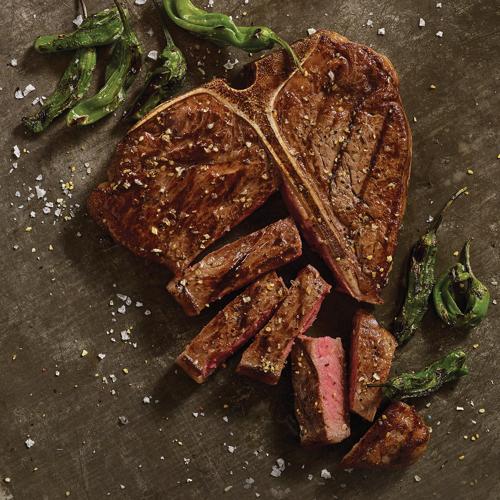You know a T-bone when you see one… it’s the steak with a T-shaped bone. But what is a T-bone, from the butcher’s perspective? This iconic steak is really two steaks in one. Bold, beefy New York strip on one side and mild, tender filet mignon on the other, separated by the t-shaped bone.
Cutting a T-bone
The T-bone is cut from the short loin subprimal from the front portion of the larger loin primal. The short loin is home to the most tender and popular cuts of steak.
The short loin is broken down further into two subprimals – the beef short loin (New York strip), and the tenderloin (filet mignon). These subprimals are separated by a bone. If they’re separated and sliced into steaks, you get those two steaks. If the short loin and tenderloin are kept together and cross-cut a saw, the result is a T-bone steak. The bone that separates the two subprimals is cut into a “T.”

Two Steaks in One
Why choose between a strip steak or a filet mignon when you can have both steaks in one when you buy T-bone steak? The filet mignon side is fork-tender and mild in flavor. The strip side of the T-bone is bold and beefy. Since these subprimals are carved from the center of the animal that receives less activity, both are delicious, tender cuts of beef.
The two distinct steaks on the T-bone are separated by bone, which insulates the meat while cooking and allows the steak to retain moisture and juiciness. However, bone-in steaks require more culinary skill for the perfect doneness. When you cook a bone-in steak, the portion closer to the bone cooks slower and the meat farther from the bone will cook faster. Indirect heat is the best cooking method for T-bones, with a quick hot sear for texture and flavor.
Porterhouse vs T-bone
T-bone and porterhouse steaks are both short-loin cross-sections, but there IS a difference. A porterhouse has a full-size filet portion because it’s cut from the anterior of the short loin where both the tenderloin and strip portion are larger. A T-bone is cut from the middle to the end of the subprimal where the tenderloin tapers and narrows. Therefore, the amount of filet mignon on a porterhouse is more than on a T-bone. Each animal will produce six to seven T-bones, and just two to three porterhouse steaks.
The size of the filet mignon and thickness of the steak will determine the classification as either a porterhouse or a T-bone. The USDA specifies that a porterhouse must be at least 1.25 inches thick measured from the widest point on the filet, and a T-bone must be 0.5 inches thick. Therefore, every porterhouse is technically a T-bone, but not every T-bone is a porterhouse.

How to Cook a T-bone
The T-bone is a unique steak to cook – technically, you’re cooking two steaks. You have to be careful since the tenderloin side will cook more quickly than the strip side. Due to this, you have to be smart about your heat.
Grill
To grill a T-bone, use both direct and indirect heat. Build a fire (or turn on burners) on just one side of the grill. Sear the T-bone 3-5 minutes per side (depending on thickness). Then, move the steak to side of the grill with no fire (indirect heat.) Make sure the filet portion of the T-bone is towards the coolest part of the grill to avoid overcooking. We recommend cooking the filet side to 125-130 degrees for the perfect rare doneness. Use our steak doneness guide and temperature chart for your preferred steak doneness. For more on grilling the perfect steak, check out our beginner’s guide to grilling.
Sear-Roast
If you can’t cook outdoors or don’t have a grill, try the sear-roast method. First sear the T-bone in a cast iron skillet. Then, add butter, fresh herbs or garlic to the skillet and roast at 300 degrees to your desired doneness.
Follow this steak cooking chart for grilling and sear roast times and instructions or download the Omaha Steaks app with a built-in timer to cook your steak to your preferred doneness.
Sous Vide
If cooking a T-bone steak seems daunting, try the sous vide method of cooking. Our executive chefs recommend seasoning your T-bone in the bag before the sous vide water bath. Once your steak has reached its desired temperature, simply sear it on the grill or in a cast iron skillet for the perfect crust. This is a fool-proof method that makes sure you don’t accidently overcook your steak.
King Cut 48 oz T-bone

T-bone Recipes:
More Butcher’s Guides:
- What is a Ribeye?
- What is an Omaha-Cut Ribeye?
- What is a Filet Mignon?
- What is a New York Strip?
- What is a Tomahawk Steak?
- What is a Top Sirloin?
- What is a Flat Iron?
Editor’s Note: This post was originally published in June 2016 and has been updated for freshness and comprehensiveness.





